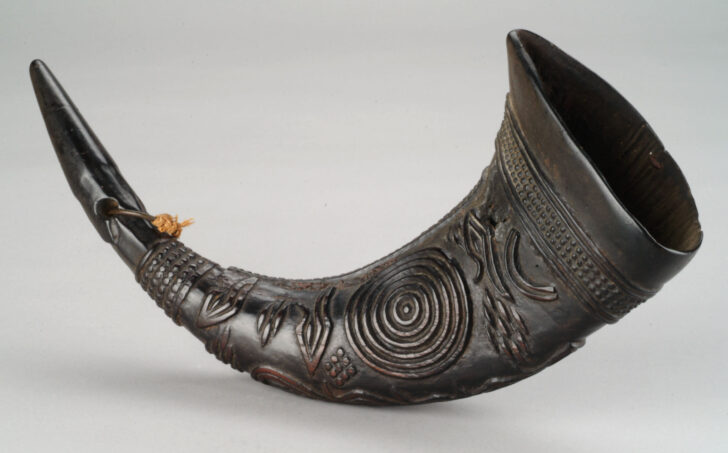Drinking Horn
Kuba

Description
March 28, 2009
An impressive array of visual arts conveyed rank and title in the Kuba Kingdom. In the nineteenth and early twentieth centuries, palm wine cups fashioned from the horns of the bush buffalo were the prerogative of Kuba warriors. This example reveals the elegant surface decoration for which Kuba artists are renowned. Its concentric circles, geometric shapes, and beadlike bands carved in relief follow the natural contours of the horn and resemble women’s scarification patterns. This horn shows an excellent local repair—a metal suture sewn at the mouth to stabilize a crack. The linear, interlocking design that covers the surface of the cylindrical wooden cup is derived from Kuba textile patterns.
The flourishing of the Kuba economy and its decorative arts came to an abrupt end in the late nineteenth century with the imposition of colonial rule, taxation, and forced labor in the rubber trade. Western collectors enthusiastically swept up remarkable pieces such as these. By the mid-twentieth century, missionary efforts to revive Kuba woodcarving and weaving led to the creation of workshops that produced objects for tourists and for export. Today, the Kuba produce textiles for themselves as well as for sale, while decorative woodcarvings are produced solely for the export market.
Subject Matter:
Drinking horns were typically made from buffalo horns and often owned by nobility or title holders. Warriors and soldiers wore them as emblems of their ferocity and connection to the wilderness. A chord was attached to the horn so the cup could be suspended from a belt when not in use. They were often used to drink palm wine. Palm wine, made from raffia palm trees, was a popular beverage among Kuba men and women. The geometric patterns on this horn are similar to patterns found on Kuba textile, basketry, sculpture, and female body scarifications.
References:
Suzanne Bier, Royal Arts of Africa, 1998
Daniel Biebuyck, The Arts of Zaire, 1985
Georges Meurant, African Textiles from the Kingdom of Kuba, 1986
Jan Vansina, The Children of Woot, 1978
Physical Description:
Buffalo horn with concentric circles, geometric shapes and beadlike bands carved in relief follow the natural contours of the horn to its pointed tip. Has a local repair—a metal suture sewn at the mouth to stabilize a crack. Has cord pierced through the tip.
Usage Rights:
If you are interested in using an image for a publication, please visit https://umma.umich.edu/request-image/ for more information and to fill out the online Image Rights and Reproductions Request Form.